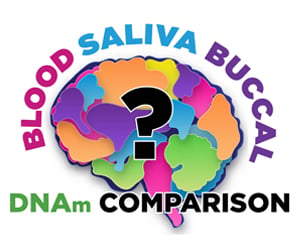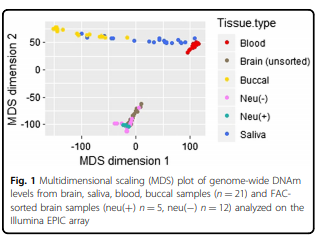2019-04-03
 DNA methylation (DNAm) has become increasingly widespread in the study of psychiatric disorders.[1] Many psychiatric epigenetic studies began to work with peripheral tissues such as blood and saliva to determine which had the best correlation with brain tissue. Researchers like Smith et al compared the DNA methylation in post-mortem tissue samples with blood and saliva and found there was a higher correlation between the brain and saliva compared to blood - DNA methylation from saliva was about 3% more likely to agree with each area of the brain regions than DNA methylation with blood.[1],[2]
DNA methylation (DNAm) has become increasingly widespread in the study of psychiatric disorders.[1] Many psychiatric epigenetic studies began to work with peripheral tissues such as blood and saliva to determine which had the best correlation with brain tissue. Researchers like Smith et al compared the DNA methylation in post-mortem tissue samples with blood and saliva and found there was a higher correlation between the brain and saliva compared to blood - DNA methylation from saliva was about 3% more likely to agree with each area of the brain regions than DNA methylation with blood.[1],[2]
Although these studies provided relevant information about the usefulness of surrogate tissues, some important questions remain: What is the relationship of DNA methylation in live human brain tissue and DNA methylation across different types of cells? Within the same individual? And within tissues collected at the same time?[2]
Braun et al, in their newly published paper titled Genome-wide DNA methylation comparison between live human brain and peripheral tissues within individuals, addressed these issues by collecting brain tissue from 27 subjects with medically intractable epilepsy during neurosurgery. They obtained saliva, blood and buccal tissue samples from the same subjects to compare genome-wide DNA methylation.[2]
Peripheral tissue correlation to brain tissue
Their first goal was to compare DNA methylation of live brain tissue to three peripheral tissues: blood, saliva, and buccal epithelial cells. They collected blood traditionally, used swabs to collect buccal cells, and used Oragene to collect saliva. Methylome assays were performed and the overall levels of DNA methylation correlation was calculated from the average methylation across subjects for each tissue using Pearson’s correlation.
To determine the degree of similarity in genome-wide DNA methylation between the peripheral-tissues and the brain, a multi-dimensional scaling (MDS) plot was graphed with all the samples. 2
 Figure 1. Braun et al. Genome-wide DNA methylation comparison between live human brain and peripheral tissues within individuals. Translational Psychiatry. 9:47 (2019).
Figure 1. Braun et al. Genome-wide DNA methylation comparison between live human brain and peripheral tissues within individuals. Translational Psychiatry. 9:47 (2019).
When the peripheral tissues were compared to the brain, high levels of correlation were observed.
- Blood – brain; r= 0.86
- Buccal – brain; r=0.85
- Saliva – brain; r = 0.90
Genome-wide DNA methylation of saliva was significantly more correlated with DNA methylation in brain than blood or buccal tissue.
Among some subjects, three brain regions were analyzed (amygdala, hippocampus, and temporal cortex). Saliva was found have a higher correlated to each region of the brain and to the whole average brain compare to blood.[2]
Peripheral tissue correlation to psychiatric-associated genes
The second goal of the study was to provide a resource for psychiatric/neurological DNA methylation studies that rely on peripheral tissues. They did this by investigating brain – peripheral tissue correlations of genes with variants involved by Genome-Wide Association Studies (GWASs) of Schizophrenia, Bipolar Disorder, and Major Depression Disorder (MDD).
For about 366 psychiatric genes, saliva showed to have the highest correlation (r=0.91), followed by blood (r = 0.88) and then buccal cells (r=0.87).[2]
Conclusion
This was the first study to use a direct comparison of live human brain tissues to the three commonly used peripheral tissues - saliva, blood and buccal cells. The data was consistent with the results of Smith et al, where saliva had the highest correlation to brain rather than blood. The variation of cell types within saliva contributes to the increasing correlations with the brain. With a mix of leukocytes and buccal cells, saliva is more closely aligned with the DNA methylation patterns of the brain; suggesting, saliva is an ideal sample type for psychiatric research studies.[2]
Related Blog: All about that base - Applications of the fifth base of DNA
To learn more about saliva collection from Oragene, please the request kits button below.
References
[1] Smith et al. DNA extracted from saliva for methylation studies of psychiatric traits: evidence tissue specificity and relatedness to brain. Am J Med Genet B Neuropsychiatr Genet. 0(1): 36-44 (2015).
[2] Braun et al. Genome-wide DNA methylation comparison between live human brain and peripheral tissues within individuals. Translational Psychiatry. 9:47 (2019).


